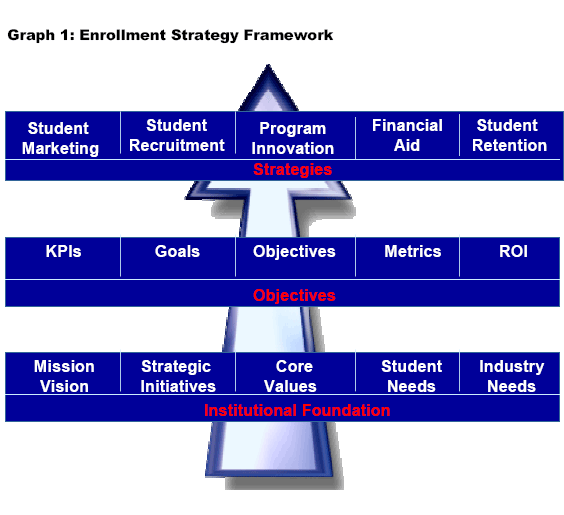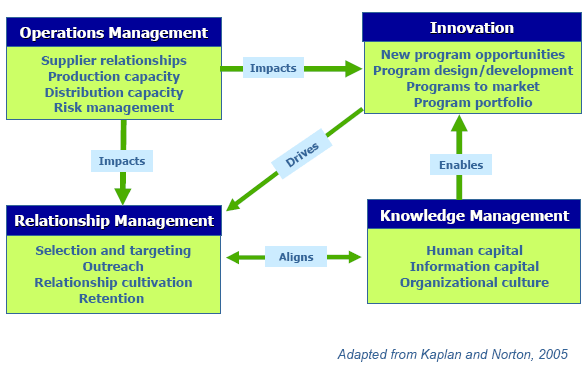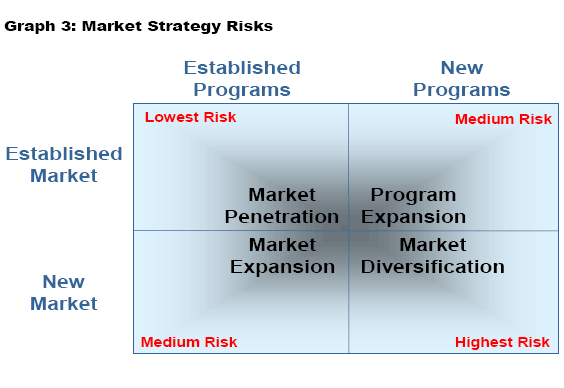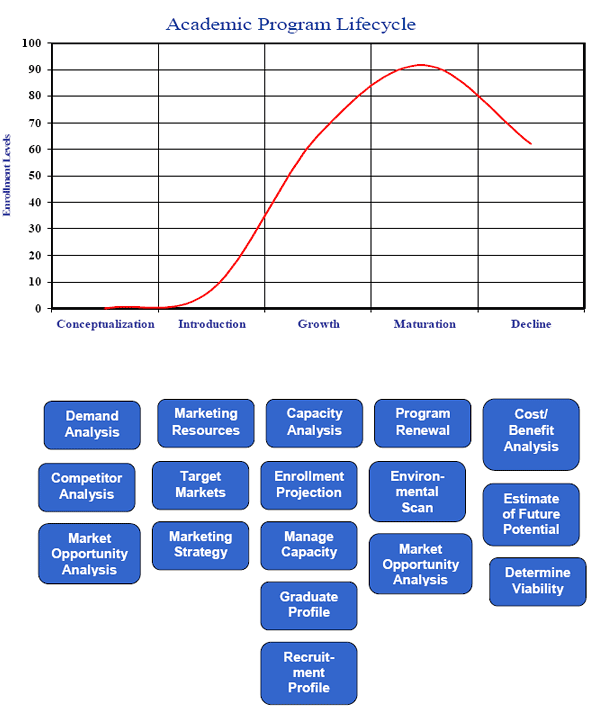Date created: January 2008
Author: Dr. Jim Black, President and CEO, SEM WORKS
For further information, contact the author at
SEM WORKS
407 Pebble Ridge Court
Greensboro, NC 27455
Web: www.semworks.net
E-mail: jimblack@semworks.net
In Sun Tzu’s The Art of War (Giles, 1910), there are many parallels to the business of enrollment management. Perhaps most pertinent to enrollment managers is the essence of war described in four dimensions: (1) know yourself (your institution’s mission, vision, strategic directions, and clientele), (2) know your enemy (your top competitors and aspirants), (3) know the ground (your campus culture, limitations, barriers and opportunities for change, priorities, traditions, symbols and artifacts, structures, as well as politics), (4) know the weather (the external environmental factors that may impact your institution’s enrollment outcomes). By understanding these dimensions and acting upon this intelligence, your probability of success dramatically increases.
Alone, such intelligence provides only modest utility in perfecting strategies. Intelligence must be applied by a high performing enrollment organization to aggressively pursue perfection. High performing enrollment organizations possess five well-developed attributes: (1) action is taken based on strategic insights like those described above; (2) enrollment operations are managed with a focus on continuous improvement of all aspects of the operation; (3) relationships are intentionally managed with all internal and external constituents; (4) knowledge is managed to ensure accuracy and quality service; and (5) innovation is the cornerstone of the enrollment enterprise.
If practiced consistently, the use of actionable intelligence along with the other characteristics of a high performing organization will ensure the quality implementation of strategies. It does not, however, guarantee the enrollment organization is working on the “right” strategies, and thus, the achievement of desired enrollment outcomes is uncertain. To target the “right” strategies, enrollment and institutional leaders are encouraged to consider the Enrollment Strategy Framework depicted in Graph 1. This framework is designed to build strategies based on internal and external factors and related institutional objectives.

Enrollment Management Strategies
Enrollment management strategies are often monolithic, growth strategies. In some circumstances the rush to grow is a counterproductive objective. Higher education leaders should heed the advice of many of their business counterparts. “Bigger is better—but only to a point. And that point is ever changeable, a function of the marketplace” (Hammond, 2002, September). Increasing enrollments is a valid objective only if a market opportunity exists, adequate funding is available for corresponding enrollment growth, and the institution has the capacity and expertise to accommodate the growth. When increasing institutional size, campus leaders should recognize the inherent risks (e.g., the organization becomes more complex; capacity is often strained beyond reasonable limits—diluting quality; and the nature of the institution changes). The chairman and chief global strategist for Starbucks, Howard Schultz, suggests that the most significant challenge in growing is to grow while staying small (Overholt, 2004, July). His premise applies to colleges and universities as well.
A more balanced and holistic approach to enrollment strategy is preferable. According to Whiteside (2001), identifying enrollment strategies requires that enrollment planners address the “who, what, where, when, and how” dimensions of strategy development. Because enrollment management is focused on people—those we seek to enroll and those we have enrolled—Whiteside suggests that strategies should be, first and foremost, people-driven. Assuming the reader subscribes to this ascertain, identifying and developing strategies for key target student segments should become the overarching construct from which enrollment strategies are designed. Of course, strategy development by segment should be based on identified institutional strategic opportunities that are supported by foundational characteristics of the institution.
Enrollment Strategy Framework
The Enrollment Strategy Framework implies that the starting point for strategy development is to revisit the institution’s mission, vision, existing strategic initiatives, and core values. Strategies should be aligned with each of the aforementioned or be accompanied with a rationale as to why a strategy is valid regardless of alignment. These internal characteristics should be compared with strategic opportunities that exist based on an assessment of student, industry, and in some cases, community needs. Although not illustrated in the Enrollment Strategy Framework, a competitor analysis also is necessary to determine the extent of the strategic opportunity (e.g., existing competitors in the market, the size of the remaining market opportunity, the degree to which the institution can secure a viable market position).
In addition, enrollment managers should assess the institution’s capacity to seize the strategic opportunity. Moreover, the institution must possess “a strategic vision for building capacity for access and enrollment growth” as well as to achieve other enrollment objectives (Kalsbeek, & McGrath, 2004). Under Kalsbeek’s leadership, the enrollment management division at DePaul University has developed capacity through applying predictive modeling, outsourcing critical enrollment functions, refocusing enrollment research, utilizing institutional resources to ensure the affordability of a DePaul education, and an adapting organizational structure to support strategy implementation. While this is not an exhaustive list of capacity elements for any institution, it does illustrate how strategies must be supported with the necessary antecedents for success.
Targeting the “Right” Strategies
Zemsky (2002, August) accurately asserts that strategies must have directional focus. Such directional focus is as important in determining which strategies not to pursue as it is in determining the “right” strategies. For enrollment organizations, directional focus should be evident in institutional enrollment objectives.
Enrollment objectives can take many forms (e.g., goals, key performance indicators, metrics, effectiveness measures, and return on investment measures). Regardless of the selected methodology, enrollment objectives must be measurable over time. They also must be utilized by enrollment planners as the basis for strategy development and enhancement.
Enrollment strategies can be categorized by strategy type (e.g., marketing, recruitment, student services, financial aid, and retention). As expressed earlier, strategies in these categories should be developed by target population with the possible exception of retention strategies that may not focus only on high risk students but also high risk experiences. For example, a Web strategy might target potential students with key selling points, the steps to enrolling, and audience-specific calls to action. A sample strategy for “visiting students” follows:
Visiting Students
Selling PointsSave money earning credits
Convenient locations and course-taking options
Transferability of credit
Viable course options available through continuing education
Success stories of visiting students
Steps to Enrolling
Submit an application for admission
Submit transcripts from your home institution
Meet with an advisor
Calls to Action
Request information
Visit campus
Apply for admission
An example of a strategy for students who were once enrolled but have not returned described here provides a more detailed template for strategy development.
| Enrollment Stage | Strategy | Objective | Effectiveness Measure | Audience | Action Steps | Delivery Method | Lead Responsibility | Due Date |
| Inquiry Generation | Solicitation to former students to include the steps to re-enrolling, a course schedule, and an application for admission | Increase inquiry pool | Number of inquiries from this source | Stop-outs within the last two years | Create Steps to Reenrolling piece; generate list of recipients; mail publications; track responses | Marketing | Two months prior to semester start |
Creating a High Performing Enrollment Organization
Admittedly, there are many factors and antecedents that determine the success of strategies. However, the author is convinced that there is nothing more important than creating the conditions for a high performing enrollment organization to ensure the pervasive, sustainable, quality execution of strategies. Such conditions consist of a work environment where employees are valued and recognized for their contributions to the enrollment effort; organizational learning is among the enrollment enterprise’s highest priorities; there exists a clear and compelling institutional and enrollment vision that employees passionately embrace; information flows freely within and between enrollment departments as well as with the rest of campus; people are held accountable to and rewarded for desired behavior; and there is an enrollment champion providing focus for the organization and inspiring others to stay the course. Regarding the latter, the focus required is one that continuously compares the current reality with the vision—creating positive tension around the gaps between the two. Focusing on the gaps is what sets apart high performing organizations from those that are constantly dealing with the crisis of the day or are responding to enrollment challenges in a panic-driven mode.
Operations Management
Beyond the conditions cited above, Graph 2 represents the substantive elements of a high performing enrollment management organization. The first, operations management, adopts a Total Quality Management principle that views processes and strategy implementation as a supply chain. The outputs will be of high quality only if the inputs are of high quality. For this reason, prudent enrollment managers focus on maintaining mutually beneficial relationships with suppliers— suppliers of students such as counselors, teachers, parents, and employers; as well as suppliers of products, services, resources, and policies that support the enrollment enterprise (e.g., internal IT staff, institutional researchers, faculty, business and finance officers, and student affairs professionals as well as external technology providers, outsourcing vendors, consultants, higher education governing boards and systems, and government agencies).
Graph 2: Characteristics of High Performing Enrollment Organizations

Enrollment managers and institutional leaders also must invest in production capacity. The capacity to produce enrollment results is primarily the people charged with implementation. Often enrollment professionals are asked, “How are the numbers?” but rarely are they asked, “How are the people that produce the numbers?” This suggests that most institutional leaders are missing the mark. Indeed, numbers are important, but the capacity of people to produce results is often the single most significant difference between achieving enrollment goals or failing to do so. Human capacity is largely determined by mind-set, skill set, knowledge, and having the tools necessary to successfully complete the task at hand. The latter refers to training, technology, information, resources, cooperation from others involved with some facet of implementation, the authority to take action, etc. Enrollment strategy implementers also need clear direction on the path to pursue, the intended outcome, and related expectations. With these antecedents for success in place, strategies typically yield the maximum outcome possible.
Distribution capacity refers to the capacity to reach and impact the constituents served by an institution. For example, institutions with exemplary learning support services but with minimal student usage produce only a modest influence over learning outcomes and retention. Likewise, even the most powerful marketing message has minimal impact on increasing awareness or enrollments if it is not conveyed with enough frequency. Marginally investing in such strategies is an unwise use of institutional resources. Colleges and universities are more effective investing properly in fewer strategies than engaging in a multitude of poorly resourced initiatives.
Every strategy has some risk associated with it. Consequently, it is essential to manage risks where possible. To effectively mitigate risks, enrollment managers must engage in due diligence before implementing strategies. Among other things, this means analyzing available data, reviewing best practices in the industry, assessing the degree to which the strategy is likely to yield desired results or gain competitive advantage, and ensuring the antecedents for success are in place. They also must evaluate ancillary costs such as internal political capital, credibility in the enrollment organization if the strategy fails, and the impact on other units within the institution.
To illustrate, consider risk management in the context of markets for academic programs. Graph 3 demonstrates the inherent risk associated with four possible strategies. As this graph depicts, the least risk is incurred when pursuing a strategy of further penetrating an existing market with existing programs. Moderate risk levels are associated with a strategy that launches new programs in established markets or takes existing programs to markets where the institution has little or no visibility or awareness. The highest risk is in attempting market diversification by expanding to a new market with a new program. These are the kinds of strategic decisions that enrollment managers and institutional leaders must make collaboratively.

Relationship Management
Selecting and targeting sounds ominous, but it is critical to designing effective marketing, recruitment, financial aid, student services, and retention strategies. The power in generic, one size fits all strategies is negligible. Evidence of this claim exists in the wholesale movement in marketing and recruitment circles to customized communications. The power in any communication is its relevance to the recipient. Similarly, student services are increasingly offered through online services via a portal or another password protected, Web-based technology. In the area of financial aid, many institutions have adopted a leveraging methodology to provide the optimal amount and type of aid to influence decisions to enroll or persist. And, retention programs generically implemented have produced modest results relative to approaches that diagnose an individual’s unique barriers to persistence or success and provide a tailored intervention.
The author has never encountered an institution that did not engage in some form of outreach. The vast majority of colleges and universities deploy an aggressive, resource-intensive outreach strategy. This does not mean, however, that such outreach activities are effective. Unless outreach is based on an analysis of enrollment trend data, market size and potential, as well as the ability to access the target audience through outreach, it is a “hit or miss” proposition— draining limited resources and capacity that could be reallocated to more productive strategies. Outreach should be strategic with a sustained presence in tier one feeder schools and organizations (providing 75% or more of student enrollments), seasonal visits to tier two schools and organizations (providing 20% or less of student enrollments), and annual visits to tier three feeders (providing 5% or less of student enrollments). All outreach activities should be promoted properly, planned to maximize opportunities, and tracked to determine the validity of future investments of time and money.
The primary purpose of outreach activities should be to generate interest and consequently, inquiries. Institutions that invest in extensive outreach, generate inquiries, and then provide minimal communication follow-up have a faulty recruitment model. The point is to generate interest and then aggressively cultivate that interest. Relationship cultivation is the most impactful recruitment strategy an institution can deploy. To cultivate a relationship with a prospective student, a college or university must have multiple touch points with the prospect throughout the recruitment cycle. Touch points should be personalized; where possible, customized; relevant; timely in terms of response time and alignment with the prospective student’s stages in the decision-making process; and delivered through multiple channels. The latter implies that communications and interactions should occur from multiple campus individuals and departments and be delivered through a variety of mediums (e.g., in person, and via phone, mail, e-mail, Web chat, Instant Messaging, blogs, video). For maximum results, communications and interactions with prospective students should be coordinated centrally to control for quality, consistency of message, timing, and synergy between contacts.
Though it may not be self-evident, retention also is related to relationship management. The literature is replete with studies that have revealed the power of proactively connecting students with faculty, staff, and their peers. Institutions need to be as intentional about cultivating relationships with current students as they are with prospective students and alumni. Whether it is through orientation, advising, academic support programs, student activities, an institution-wide communications plan or another strategy aimed at current students, relationships matter. To some degree, relationships influence a student’s desire to persist, engage in learning, participate in extracurricular activities, and become loyal to the institution.
Knowledge Management
As previously inferred, a high performing enrollment organization requires an investment in human capital. By investing in employee learning, ensuring conditions for high performance exist, and pursuing employee retention strategies, it is possible to maximize human capital. One of the most frustrating and often, disenfranchising experiences students have with an institution is to encounter an employee who is unable to provide a service or accurate information. On many college campuses, the turnover among frontline staff is considerable. This phenomenon is most often caused by substandard salaries and work conditions or by unrealistic performance expectations. Every time an employee leaves an institution, service suffers. They leave with knowledge and experience that may not be replaced at an equivalent level for up to two years given the time required to conduct a search, hire the successful candidate, and move the individual along the learning curve. This is a tremendous blow to the effectiveness of an enrollment organization. High performing organizations find ways to retain and grow their employees.
Information capital is frequently misinterpreted to mean training. While training is a component of developing information capital, it has modest value in a complex, ever-changing institutional environment. The currency and retention of information acquired through training is questionable. A more sustainable and actionable approach to developing information capital is providing ubiquitous access to just-in-time information—exactly what the service provider needs when they need it to assist a student. A few institutions are managing just-in-time information through an intranet or enterprise portal. The challenge with this approach is keeping the information current. Even the most accessible and intuitive systems work only if the information is accurate.
Developing human capital and managing information is of little consequence if it is not accompanied by a corresponding culture change. A high performing enrollment enterprise possesses an organization culture where knowledge is valued and accurate information is sacred. In such a culture, it is everyone’s job to ensure students are provided with the information they need to make sound and timely decisions. Employees take pride in maintaining data integrity, reducing student runaround, and preventing errors that cause student problems. Generally, such an organizational culture emanates from the enrollment leader but thrives in an environment of self and mutual accountability.
Innovation
Innovation, in this context, refers to academic program innovation. However, this focus does not imply that strategy innovation is unimportant. Academic program innovation is the focus here because enrollment managers often do not perceive this as within their purview, but the academic program mix is central to enrollment success. Few institutions can overcome a stale or antiquated array of program offerings. Having the “right” programs, in the “right” markets, delivered in a manner that is conducive to the learning preferences of potential students in those markets is mission critical.
The following illustration depicts the lifecycle of academic programs with marketing and enrollment research and strategies recommended for each stage of the lifecycle. It is important to note that not all academic programs follow this lifecycle. To the contrary, many programs follow a more pendulum-like pattern with demand increasing or decreasing based on the demand in the job market. Nonetheless, the research and strategies are still applicable.

- The demand analysis should occur when a new program is being considered. It consists of an analysis of student, industry, and community demand. Demand among one of the aforementioned populations without the other two suggests a program that has limited potential. The analysis should not be limited to a determination of need for the program but should include preferred program delivery method (e.g., in class/lab/studio, online, or hybrid model), course delivery times and days (e.g., daytime, evening, weekend, compressed semesters), and instructional methodology (e.g., lecture, interactive, hands-on, field placements, integrated technology). Findings generated from the demand analysis should not be adopted at the sacrifice of sound pedagogy.
- A competitor analysis should be used to assess market potential for new programs. An in-depth competitor analysis will provide information regarding market saturation and expose potential unclaimed or underserved niches. The effective positioning of a new program is critical to its success.
- The market opportunity analysis recommended for the conceptual stage of program development is designed to identify market size, market share potential, as well as target populations inclined to respond positively to the new program offering. Regarding targeting populations, segmenting zip code clusters by demographic characteristics, academic profile, institutional perceptions compared to competitors, likelihood to enroll at your college, perceived barriers to enrolling at your college, media preferences, and communication preferences will supply the institution with information that can be used to strategically target marketing and communication activities. This portion of a market opportunity analysis is best conducted through a combination of constituent surveys and secondary data.
- Adequate marketing resources should be identified prior to the launch of any new program. Too often new programs are created without a thoughtful marketing plan. The “Field of Dreams” model of program enrollment can work if the demand is high and the market is void of strong competitors, but it never yields optimal results. If a program is worthy of academic investment, it is certainly worthy of marketing investment.
- Defining target markets is perhaps the most important facet of a successful launch. Identify target populations along with the problem your program will solve for them. By casting your program as a solution rather than simply as another program offering will compel people to enroll. Come to understand their needs, and ensure the new program addresses identified needs.
- The marketing strategy should be multifaceted: awareness building, lead generation, inquiry cultivation, and applicant conversion. It should include specific, measurable objectives for each strategy along with the antecedents necessary for a successful implementation. Said strategies should be academic unit- and college-based with a high level of orchestration between the two. The strategy should focus on related industries and agencies, schools, as well as potential students.
- During the growth stage, it is imperative to engage in a capacity analysis. This analysis should determine the optimal number of students given institutional resources such as classroom and lab space, available clinicals or internships, faculty teaching loads within the program, the need for and availability of service courses in other disciplines, and the capacity of necessary support services. More students than institutional capacity is a prescription for failure—insufficient class availability, delayed time to degree, student dissatisfaction, attrition, and poor program and institutional reputation. The ability to deliver on promises inherent in a program offering is particularly important for schools that draw from a fairly localized market. In regional markets, “word-of-mouth” is your most powerful recruitment tool. Students will inevitably share their experiences at your college with others—positive or negative experiences.
- As enrollment in a program grows, it is essential to forecast and plan for future enrollments. Enrollment projections that account for new student demand as well as migration between college programs and student retention will allow the institution to ensure adequate capacity exists to serve the needs of all enrolled students.
- Using capacity analysis data and enrollment projections, your institution can manage capacity to ensure an exemplary educational experience for students in any program. Effectively managing capacity means ramping up when necessary (e.g., increased sections, additional faculty, expanded number of online courses, new locations). Such planning should occur early in the academic calendar to avoid last minute searches for space or instructors and potentially diminishing the quality of instruction.
- A graduate profile can be used to create a recruitment profile. By identifying students who have been successful in the past, an institution can effectively search for new students who possess similar characteristics— enhancing recruitment and retention efforts.
- Program renewal is essential at the maturation stage of any program. The needs of your community, local industry, and students are fluid and thus, must be assessed periodically with appropriate changes occurring to curriculum, pedagogy, and delivery mechanisms.
- An environmental scan should consist of an analysis of global, national, state, and local trends in technology, social values and lifestyles, labor force, education, economic, and demographics.
- The market opportunity analysis described earlier should be repeated during every program review cycle.
- The recommended cost/benefit analysis has three components: (1) the cost to run the program versus the revenue produced by program enrollments, (2) the benefits to students, industry, and the service region, and (3) impact on desired institutional outcomes. The analysis of programs with waning enrollments is intended to combine quantitative and qualitative measures and balance objective and subjective findings. Programs with a negative net revenue should have compelling evidence of external benefits and internal impact in order to demonstrate program viability.
- An estimate of future potential accounts for the “pendulum-like pattern” alluded to earlier that is found in demand for some programs. This estimate should consider current labor market trends and projections along with student academic interest trends.
- Finally, it is up to senior management, with guidance from the academic leadership, to determine viability of programs.
When practiced methodically, these research and enrollment strategies will ensure institutions maximize program opportunities, programs are designed with the needs of the market as a barometer, programs with the most potential in a given market are identified, and the program portfolio is robust—enabling, not impeding the achievement of enrollment objectives.
Conclusion
Enrollment strategies have the highest potential of impacting institutional objectives when enrollment leaders know the institution and those you serve, know the competition, know how to get things done on the campus, and know the environmental factors that may impact enrollment outcomes. The successful execution of the “right” strategies then is determined by the degree to which the institution has developed a high performing enrollment organization. Actionable intelligence and a commitment to high performance represent a formidable enrollment duo. With these attributes, any enrollment organization can obtain and sustain a competitive advantage as well as serve and retain its current students.
References
Giles, L. (1910). The art of war. English translation published by the U.S. Military. Washington, DC: Gutenberg Project.
Hammond, K. H. (2002, September). Size is not a strategy. New York: Fast Company, (78–84).
Kalsbeek, D. & McGrath, J. (2004). Structural, strategic, and tactical innovations—SEM at DePaul University. In J. Black (Ed.), Essentials of enrollment management: Cases in the field. Washington, DC: American Association of Collegiate Registrars and Admissions Officers.
Kaplan, R. & Norton, D. (2005). The balanced score card. Northamptonshire, UK: Chartered Management Institute.
Overholt, A. (2004, July). Listening to Starbucks. New York: Fast Company, (50– 53).
Whiteside, R. (2001). Models of successful change. In J. Black (Ed.), The strategic enrollment management revolution. Washington, DC: American Association of Collegiate Registrars and Admissions Officers.
Zemsky, R. (2002, August). Strategy without deep pockets: Enhancing institutional capacity from within. Philadelphia, PA: Exemplars.



